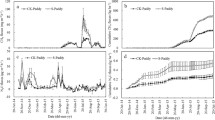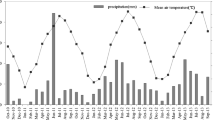Abstract
To evaluate the effects of straw-based biochar on greenhouse gas emissions from paddy fields, a field study was conducted on a typical paddy field in subtropical China to compare the greenhouse gas emissions induced by rice straw and straw-based biochar incorporation. The cumulative CH4 emissions were 281–515 kg CH4 ha−1 for the straw incorporation treatments, which were 2.6–6.4 times higher than with the biochar treatments. The cumulative N2O emissions were 75.7–135 g N2O ha−1, and there was no significant difference between treatments. The calculated global warming potentials (GWPs) were 7,055–12,906 kg CO2-eq ha−1 for straw incorporation treatments, while those for the biochar incorporation treatments were only 1,776–2,004 kg CO2-eq ha−1. When divided by yield, the yield-scaled GWPs were 1,127–2,081 kg CO2-eq Mg−1, which were 2.0–7.0 times higher than those of the biochar treatments. The GWPs and yield-scaled GWPs of the greenhouse gases from the paddy field with straw-based biochar incorporation were much lower than with straw incorporation, indicating that the conversion of straw to straw-based biochar can be an effective means of carbon sequestration in rice production and can even increase grain yields to some degree. However, the long-term effects of biochar incorporation in paddy fields need further study.
Authors Jianlin Shen and Hong Tang were contributed equally to this work.
Access provided by Autonomous University of Puebla. Download conference paper PDF
Similar content being viewed by others
Keywords
Introduction
Straw incorporation in paddy fields is often criticized because of its large contribution to global warming and is discouraged by some researchers (e.g., Yan et al. 2009). Recently, biochar, i.e., charred materials, usually from plant residues, has been applied to soils in crop production and shown positive effects on crop yield, greenhouse gas emission reduction, and soil carbon sequestration (Lehmann and Joseph 2009). But little is known about the differences of greenhouse gas emissions following straw and straw-based biochar incorporation in paddy fields. Here, a field study was conducted in a typical paddy field in Hunan province in subtropical China to compare greenhouse gas emissions following straw and straw-based biochar incorporation.
Materials and Methods
The experimental field was located in Jinjing town, Changsha County, Hunan province, China (113°19′52″ E, 28°33′04″ N). The soil was classified as hydromorphic, consisting of 51.9% sand, 30.9% silt, and 17.2% clay with an initial pH (H2O) of 5.1. Total N and organic C were 0.26% and 1.92%, respectively. The annual mean precipitation and air temperature at the site are 1,300 mm and 16.9°C, respectively. The rice cultivar d was Jinyou 207. Rice seedlings at about 30 days old were transplanted on July 23, 2011. The N fertilizer (urea, applied 150 kg N ha−1) was applied three times: during transplanting, early tillering stage, and heading stage with a ratio of 4׃4:2. The P and K fertilizers were applied at a rate of 50 kg P2O5 and 110 kg K2O ha−1, respectively, and were all used as basal fertilizers. The water management followed local practice. After transplanting, the paddy field was kept flooded for about 30 days. Then a 10-day midseason aeration was imposed followed by intermittent irrigations until rice harvest, on 22 October 2011. Five treatments were adopted. These were NPK (control treatment, inorganic NPK), NPK + LS (additional rice straw incorporation at 3 t ha−1 dry matter), NPK + HS (additional rice straw incorporation at 6 t ha−1 as dry matter), NPK + LC (additional straw-based biochar incorporation at 7.5 t ha−1 as dry matter), and NPK + HC (additional straw-based biochar incorporation at 22.5 t ha−1 as dry matter). The experimental design was a completely randomized block design with triplicates. The plot area was 35 m2 (7 m by 5 m). Greenhouse gas emission fluxes were determined by the closed chamber method. The gas sampling was conducted during 9:00–11:00, and four gas samples were collected from the closed chamber at intervals of 10 min each sampling day. The sampling frequency was once a week and increased to twice a week during the first 10 days after N fertilizer applications and midseason aeration. The gas concentrations were measured by gas chromatograph (Angilent 7890A) equipped with a flame ionization detector for CH4 and CO2 analyses and an electron capture detector for N2O analyses. The grain yields of each plot were measured after harvesting.
Results and Discussion
The measured CH4, apparent CO2 (the sum of plant and soil respiration), and N2O emission fluxes during the rice season are shown in Fig. 1. The CH4 fluxes were much higher following straw incorporation than after biochar incorporation, and this trend lasted for 6 weeks after transplanting. Though CH4 fluxes increased with increasing rates of straw incorporation, there were no significant differences in the CH4 fluxes with different incorporation rates of biochar. The apparent CO2 fluxes showed no significant differences between treatments with or without biochar addition, indicating that the biochar was recalcitrant in the paddy fields and can be used for carbon sequestration in rice production. The N2O fluxes were generally low in all treatments and showed no significant differences between treatments. The cumulative CH4 emissions were 281–515 kg CH4 ha−1 following straw incorporation, which were 2.6–3.0 and 5.5–6.4 times higher than the NPK + LS and NPK + HS biochar treatments, respectively. The cumulative N2O emissions were 75.7–135 g N2O ha−1, and there was no significant difference between treatments. The calculated global warming potentials were 7,055–12,906 kg CO2-eq ha−1 in the straw incorporation treatments with CH4 contributing 99.7% of GWPs, while the GWPs for the biochar incorporation treatments were only 1,776–2,004 kg CO2-eq ha−1 with CH4 contributing, on average, 98.2% of GWPs. As the increasing world population needs more food in the future, more cereals need to be produced. One way to achieve this is by intensification of crop production, e.g., through using more N fertilizer. From a sustainable point of view, the projected required that increase in yield should not cause more greenhouse gas emissions (Linquist et al. 2011). The yield-scaled GWPs were 1,127–2,081 kg CO2-eq Mg−1 for the straw incorporation treatment, which were 2.0–3.3 (NPK + LS) and 4.5–7.0 (NPK + HS) times higher than the biochar treatments. Therefore, the conversion of straw to straw-based biochar can be an effective means of carbon sequestration in rice production (Table 1).
References
Lehmann, J., and S. Joseph. 2009. Biochar for environmental management: An introduction. In Biochar for environmental management, ed. J. Lehmann and S. Joseph, 1–12. London: Earthscan.
Linquist, B., K. van Groenigen, M.A. Adviento-Borbe, C. Pittelkow, and C. van Kessel. 2011. An agronomic assessment of greenhouse gas emissions from major cereal crops. Global Change Biology. doi:10.1111/j.1365-2486.2011.02502.x.
Yan, X.Y., H. Akiyama, K. Yagi, and H. Akimoto. 2009. Global estimations of the inventory and mitigation potential of methane emissions from rice cultivation conducted using the 2006 Intergovernmental Panel on Climate Change Guidelines. Global Biogeochemical Cycles 23: GB2002.
Author information
Authors and Affiliations
Corresponding author
Editor information
Editors and Affiliations
Rights and permissions
Copyright information
© 2013 Zhejiang University Press and Springer Science+Business Media Dordrecht
About this paper
Cite this paper
Shen, J., Tang, H., Liu, J., Li, Y., Ge, T., Wu, J. (2013). A Comparison of Greenhouse Gas Emissions from a Paddy Field Following Incorporation of Rice Straw and Straw-Based Biochar. In: Xu, J., Wu, J., He, Y. (eds) Functions of Natural Organic Matter in Changing Environment. Springer, Dordrecht. https://doi.org/10.1007/978-94-007-5634-2_190
Download citation
DOI: https://doi.org/10.1007/978-94-007-5634-2_190
Published:
Publisher Name: Springer, Dordrecht
Print ISBN: 978-94-007-5633-5
Online ISBN: 978-94-007-5634-2
eBook Packages: Earth and Environmental ScienceEarth and Environmental Science (R0)





